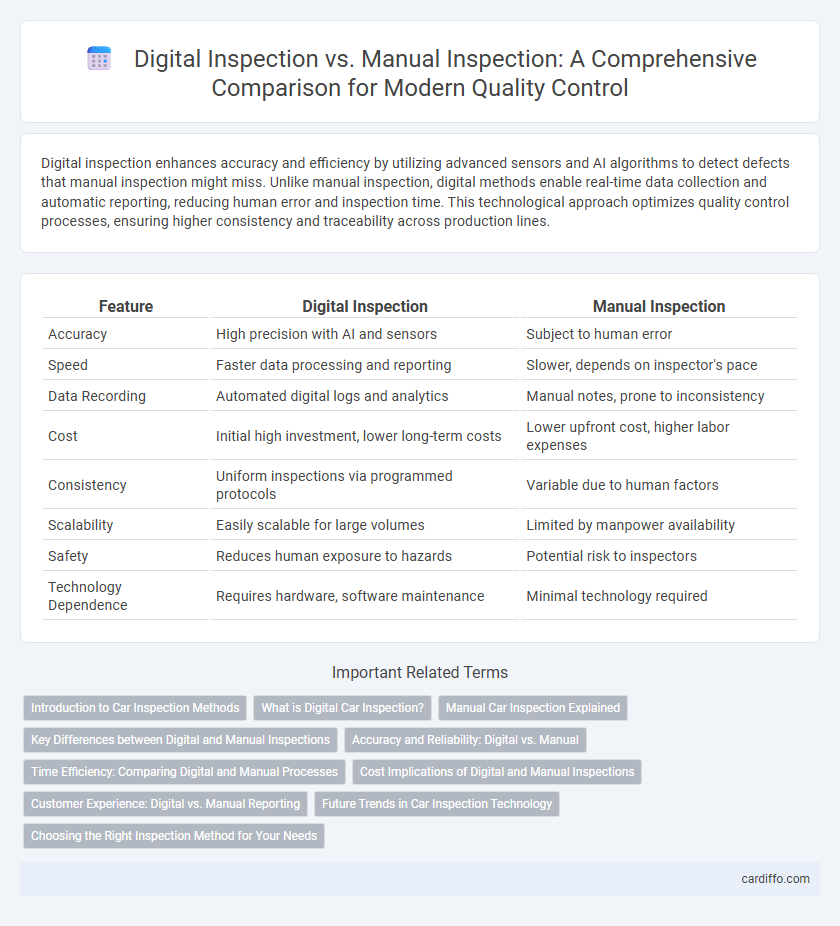Digital inspection enhances accuracy and efficiency by utilizing advanced sensors and AI algorithms to detect defects that manual inspection might miss. Unlike manual inspection, digital methods enable real-time data collection and automatic reporting, reducing human error and inspection time. This technological approach optimizes quality control processes, ensuring higher consistency and traceability across production lines.
Table of Comparison
| Feature | Digital Inspection | Manual Inspection |
|---|---|---|
| Accuracy | High precision with AI and sensors | Subject to human error |
| Speed | Faster data processing and reporting | Slower, depends on inspector's pace |
| Data Recording | Automated digital logs and analytics | Manual notes, prone to inconsistency |
| Cost | Initial high investment, lower long-term costs | Lower upfront cost, higher labor expenses |
| Consistency | Uniform inspections via programmed protocols | Variable due to human factors |
| Scalability | Easily scalable for large volumes | Limited by manpower availability |
| Safety | Reduces human exposure to hazards | Potential risk to inspectors |
| Technology Dependence | Requires hardware, software maintenance | Minimal technology required |
Introduction to Car Inspection Methods
Digital inspection leverages advanced technologies such as high-resolution cameras, sensors, and AI algorithms to quickly identify vehicle defects and anomalies with greater accuracy and efficiency. Manual inspection relies on trained technicians performing physical checks and assessments, which can be time-consuming and subject to human error. Combining digital tools with expert manual evaluation enhances the thoroughness and reliability of car inspection methods.
What is Digital Car Inspection?
Digital car inspection utilizes advanced technologies such as high-resolution cameras, sensors, and AI-powered diagnostic tools to assess a vehicle's condition quickly and accurately. This method captures detailed data on engine performance, structural integrity, and exterior defects, enabling real-time analysis and reporting. Compared to manual inspection, digital inspection reduces human error, increases efficiency, and provides comprehensive documentation accessible via digital platforms.
Manual Car Inspection Explained
Manual car inspection involves a trained technician thoroughly examining a vehicle's mechanical components, body, and interior to identify any issues or potential problems. This hands-on approach allows inspectors to detect subtle signs of wear, leaks, or damage that digital tools may miss, ensuring a comprehensive assessment of the car's condition. Despite advances in digital inspection technology, manual inspections remain essential for accurate diagnostic evaluation and personalized maintenance recommendations.
Key Differences between Digital and Manual Inspections
Digital inspections utilize advanced technologies such as drones, sensors, and AI-powered analytics to capture and analyze data, enabling faster, more accurate, and comprehensive assessments compared to manual inspections. Manual inspections rely on human observation and physical tools, which can be time-consuming, prone to error, and limited by accessibility challenges. The integration of digital tools enhances data consistency, real-time reporting, and remote monitoring capabilities, significantly improving efficiency and decision-making processes in inspection tasks.
Accuracy and Reliability: Digital vs. Manual
Digital inspection leverages advanced sensors and automated data analysis, resulting in higher accuracy and consistent reliability compared to manual inspection methods. Manual inspection relies heavily on human judgment and can be prone to errors and variability, affecting the precision and repeatability of results. Digital systems enhance defect detection rates and provide comprehensive data records, ensuring more reliable quality control processes.
Time Efficiency: Comparing Digital and Manual Processes
Digital inspection significantly reduces time efficiency by automating data capture and analysis, enabling rapid identification of defects compared to manual inspection. Manual inspection relies on human observation, which is inherently slower and prone to inconsistencies, leading to longer inspection cycles. The use of advanced digital tools streamlines reporting and real-time monitoring, cutting inspection time by up to 50% in industrial environments.
Cost Implications of Digital and Manual Inspections
Digital inspections significantly reduce labor costs and minimize errors, leading to lower rework expenses and faster project completion. Manual inspections often incur higher operational costs due to increased time, reliance on skilled personnel, and susceptibility to human error. Investing in digital inspection technologies can result in substantial cost savings and improved overall efficiency for quality control processes.
Customer Experience: Digital vs. Manual Reporting
Digital inspection reporting enhances customer experience by providing real-time access to detailed, accurate data through intuitive platforms, reducing errors and enabling faster issue resolution. Manual inspection reports often face delays, inconsistencies, and limited accessibility, which can hinder clear communication and timely customer feedback. Emphasizing digital solutions improves transparency, boosts customer trust, and streamlines service delivery.
Future Trends in Car Inspection Technology
Digital inspection in car maintenance leverages AI-powered image recognition and IoT sensors to enhance accuracy and reduce inspection time compared to traditional manual methods. Future trends indicate increased integration of augmented reality (AR) for real-time diagnostics and blockchain technology for secure, tamper-proof vehicle inspection records. These advancements promise to transform car inspection by improving efficiency, reliability, and data transparency.
Choosing the Right Inspection Method for Your Needs
Digital inspection leverages advanced technologies such as AI, drones, and high-resolution imaging to deliver faster, more accurate results, making it ideal for complex or large-scale projects requiring detailed analysis. Manual inspection remains valuable for tasks needing human judgment, tactile assessment, or in environments where technology access is limited. Selecting the right inspection method hinges on factors like project scale, accuracy requirements, available budget, and environmental conditions to ensure efficient and reliable outcomes.
Digital inspection vs manual inspection Infographic

 cardiffo.com
cardiffo.com